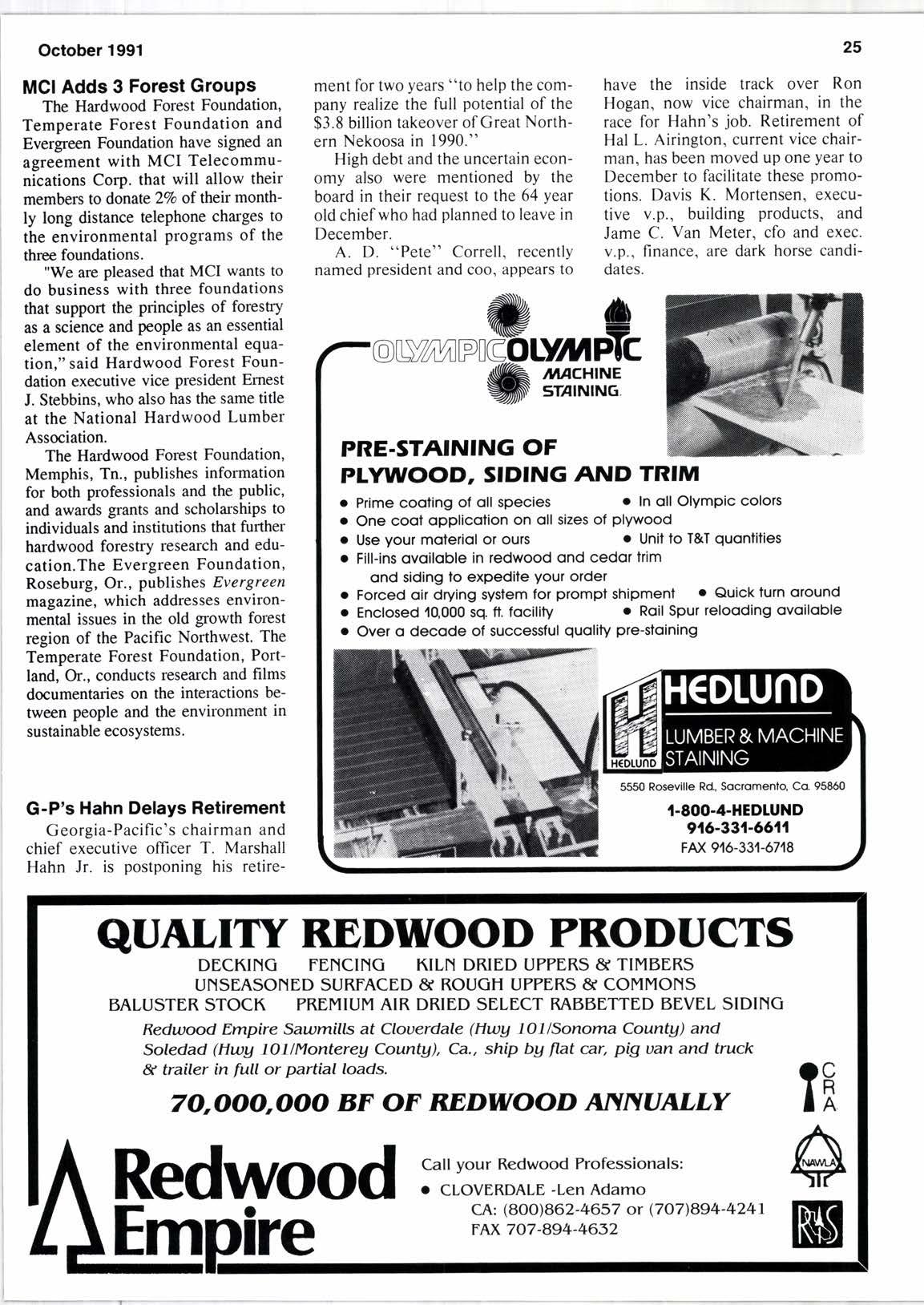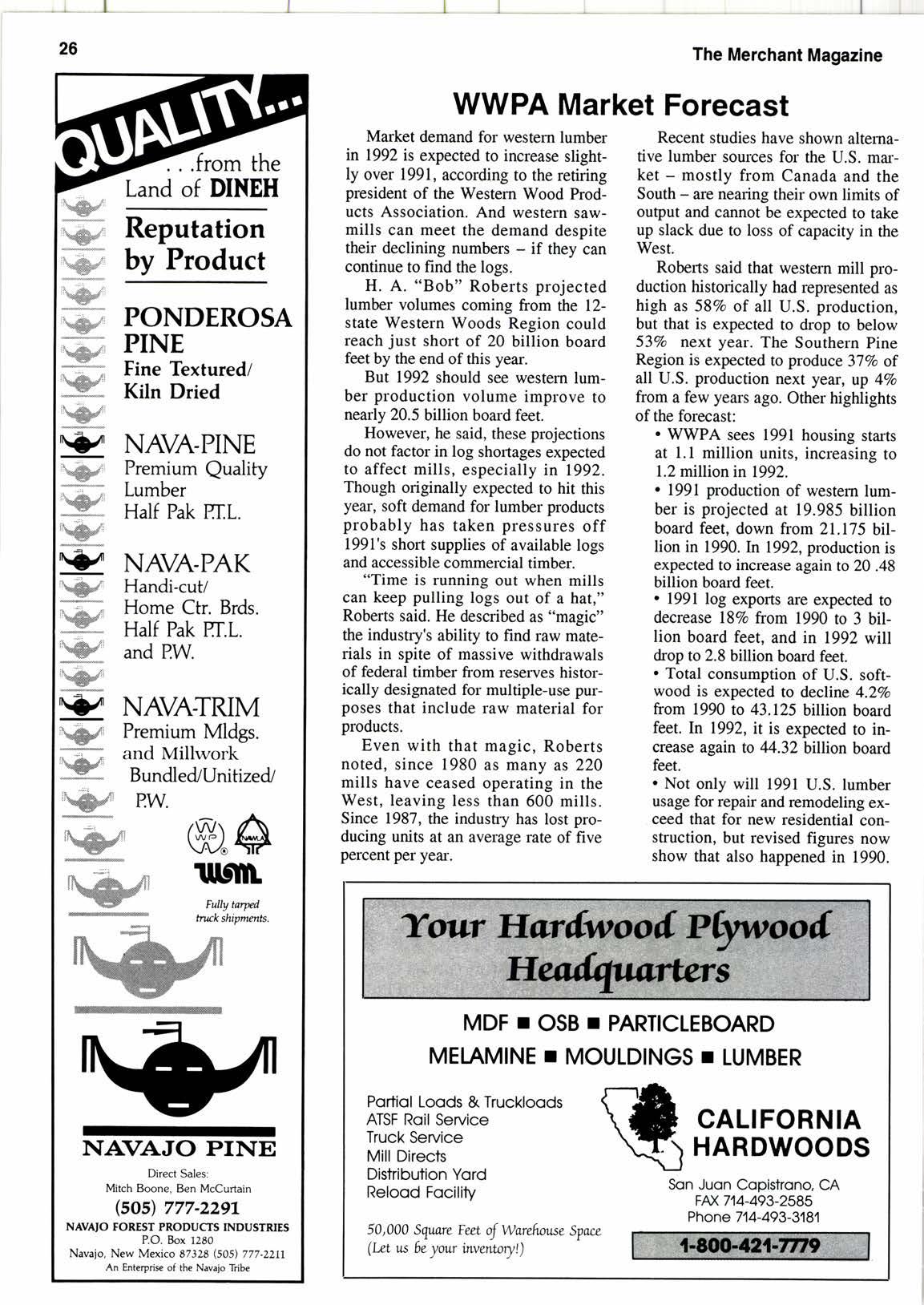
5 minute read
Pay 'N Pak Files Chap. 11, Sets New Goals
Pay'N Pak Storcs, Inc., Kent, Wa., filed for Chapter I I bankluptcy protection Sept. 2l with expectations of keeping daily operations continuing unintenupted.
Affiliated entities of parent company RNP Holdings Corp. were excluded from the filing. Lenders headed by Manufacturers Hanover Trust Co. agreed to $100 million in debtor-inpossession financing, a $40 million credit line increase.
In previous cost cutting, Pay 'N Pak put 24 Califomia stores on the market and began liquidation sales (see Tfte Merchant, Sept., p.24) Within the last 12 months the company closed a Califomia distribution center, sold the corporate jet and fired employees.
"With the court's approval, we intend to move ahead with our plans to reshape and sheamline Pay 'N Pak to return the company to its position as one of the Northwest's leading home improvement centers," chairman and chief executive officer John H. Markley said. "We believe we have already made significant progress to- ward that goal as evidenced by the overwhelming success of our new stores in Puyallup and Walla Walla, Wa."
A leveraged buyout by management prior to 1989 resulted in losses of $12.8 million in 1988 and $12.2 million in 1989. Losses in 1990 and l99l were reduced to $6.2 million and $8.4 million.
The prototype, high-tech, 44,000 sq. ft. Puyallup home improvement center opened in June. A Walla Walla unit opened Sept. 14. Both offer design consultation, an expanded selection of textiles, computer aided design and a design center.
Pay'N Pak management, which has been reshaping the company since they took over in late 1989, has said theyle not after the warchouse customer. but want to develop a new concept in home improvement merchandising based on professional design assistance.
Pay 'N Pak cunently operates 78 retail home improvement centers in 14 westem states including Alaska and Ha-
The Merchant waii, with the majority of the locations in the northwest including Canada.
Housing Begins Recovery
The housing slump may have bottomed out, as residential real estate sales and values steadily rise, according to a survey of bank examiners and liquidators.
The government survey revealed consistent improvement over the last six months, especially in the West, South and Midwest. Building permits have also increased since the low point at the beginning of the year.
Concurrently, the National Association of Realtors reported home sales rose by 1.8% in the first quarter as prices and interest rates remained low.
New Building Products Show
The National Building Products Exposition & Conference will be launched Aug. l5-18, 1992, Rosemont Convention Center, Chicago, Il., in conjunction with the National Hardware Show and Hardware Industry Week.
MCI Adds 3 Forest GrouPs
The Hardwood Forest Foundation, Temperate Forest Foundation and Evergreen Foundation have signed an agreement with MCI Telecommunications Corp. that will allow their members to donate 2Vo of theit monthly long distance telephone charges to the environmental Programs of the three foundations.
"We are pleased that MCI wants to do business with three foundations that support the principles of foresry as a science and people as an essential element of the environmental equation," said Hardwood Forest Foundation executive vice president Emest J. Stebbins, who also has the same title at the National Hardwood Lumber Association.
The Hardwood Forest Foundation, Memphis, Tn., publishes information for both professionals and the public, and awards gnnts and scholarships to individuals and institutions that further hardwood forestry research and education.The Evergreen Foundation, Roseburg, Or., publishes Evergreen magazine, which addresses environmental issues in the old gowth forcst region of the Pacific Northwest. The Temperate Forest Foundation, Portland, Or., conducts research and films documentaries on the interactions between people and the environment in sustainable ecosystems.
G-P's Hahn Delays Retirement
Georgia-Pacific's chairman and chief executive oflicer T. Marshall Hahn Jr. is postponing his retire- ment for two years "to help the company realize the full potential of the $3.8 billion takeover of Great Northern Nekoosa in 1990."
High debt and the uncertain economy also were mentioned by the board in their request to the 64 year old chief who had planned to leave in December.
A. D. "Pete" Correll, recently named president and coo, appears to have the inside track over Ron Hogan, now vice chairman, in the race for Hahn's job. Retirement of Hal L. Airington, current vice chairman, has been moved up one year to December to facilitate these promotions. Davis K. Mortensen, executive v.p., building products, and Jame C. Van Meter, cfo and exec. v.p., finance, are dark horse candidates.
PRE.STAINING OF PIYWOOD, SIDING AND TRIM
o Prime coofing of oll species o In oll Olympic colors One cool opplicotion on oll sizes of plywood o Use your moleriol or ours o Unil fo I&T quontifies o Fill-ins ovoiloble in redwood ond cedor trim ond siding lo expedite your order

. Forced oir drying sysfem for prompi shipment o Enclosed10000 sq. tt focility o Quick furn oround o Roil Spur relooding ovoiloble
. Over o decode of succesful quolity pre-sloining
WWPA Market Forecast
Market demand for western lumber in 1992 is expected to increase slightly over 1991, according to the retiring president of the Westem Wood hoducts Association. And western sawmills can meet the demand despite their declining numbers - if they can continue to find the logs.

H. A. "Bob" Roberts projected lumber volumes coming from the 12state Western Woods Region could reach just short of 20 billion board feet by the end ofthis year.
But 1992 should see westem lumber production volume improve to nearly 20.5 billion board feet.
However, he said, these projections do not factor in log shortages expected to affect mills, especially in 1992. Though originally expected to hit this year, soft demand for lumber products probably has taken pressures off 1991's short supplies of available logs and accessible commercial timber.
"Time is running out when mills can keep pulling logs out of a hat," Roberts said. He described as "magic" the industry's ability to find raw materials in spite of massive withdrawals of federal timber from reserves historically designated for multiple-use purposes that include raw material for products.
Even with that magic, Roberts noted, since 1980 as many as 220 mills have ceased operating in the West, leaving less than 600 mills. Since 1987, the industry has lost producing units at an average rate of five percent per year.
Recent studies have shown alternative lumber sourrces for the U.S. market - mostly from Canada and the South - are nearing their own limits of output and cannot be expected to take up slack due to loss of capacity in the West.
Roberts said that western mill production historically had represented as high as 58Vo of all U.S. production, but that is expected to drop to below 53Vo next year. The Southern Pine Region is expected to produce 37Vo of all U.S. production next year, up 4Vo from a few years ago. Other highlights of the forecast: l99l log exports are expected to decrease l87o from 1990 to 3 billion board feet, and in 1992 will drop to 2.8 billion board feet.
WWPA sees l99l housing starts at 1.1 million units, increasing to 1.2 million in 1992.
. l99l production of western lumber is projected at 19.985 billion board feet, down from 21.175 billion in 1990. In 1992, production is expected to increase again to 20 .48 billion board feet.
. Total consumption of U.S. softwood is expected to decline 4.2Vo from 1990 to 43j25 billion board feet. In 1992, it is expected to increase again to 44.32 billion board feet.
. Not only will l99l U.S. lumber usage for repair and remodeling exceed that for new residential construction, but revised figures now show that also happened in 1990.
October 1991
However, projections show 1992 repair-remodel usage of 14.965 billion board feet will slip behind new home construction, which will require 15.435 billion board feet.
. Because of softer export markets and an improving U.S. demand in 1992, foreign lumber imports into the U.S. are expected to increase from I 1.7 billion board feet in l99l to 12.125 billion board feet, virtually all from Canada.










